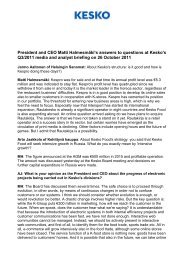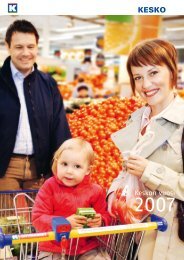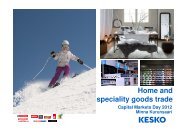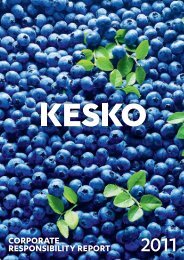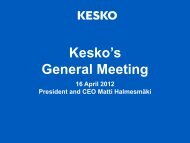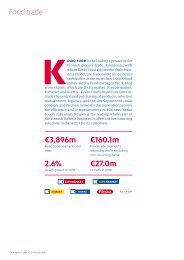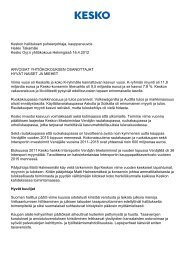Kesko's Annual Report 2009
Kesko's Annual Report 2009
Kesko's Annual Report 2009
You also want an ePaper? Increase the reach of your titles
YUMPU automatically turns print PDFs into web optimized ePapers that Google loves.
Other intangible assets<br />
The cost of intangible assets with definite useful lives are stated<br />
in the balance sheet and recognised as expenses during their<br />
useful lives. Such intangible assets include software licences and<br />
customer relationships to which acquisition cost has been allocated<br />
upon acquisition, and leasehold interests that are amortised<br />
during their probable terms. The estimated useful lives are:<br />
Computer software and licences 3–5 years<br />
Customer and supplier relationships 10 years<br />
Research and development expenses<br />
The Group has not had such development expenditures which,<br />
under certain conditions, should be recognised as assets and<br />
written off during their useful lives in accordance with IAS 38.<br />
Therefore the costs of research and development activities have<br />
been expensed as incurred.<br />
Computer software<br />
The labour costs and other direct expenditure of the Group<br />
employees working on new software development projects are<br />
capitalised as part of the software cost. In the balance sheet,<br />
computer software is included in intangible assets and its cost is<br />
written off during the useful life of the software. Software maintenance<br />
expenditure is recognised as an expense as incurred.<br />
Property, plant and equipment<br />
Property, plant and equipment mainly comprise land, buildings,<br />
machinery and equipment. Property, plant and equipment are<br />
carried at original cost net of planned depreciation and any<br />
impairment. The property, plant and equipment of acquired<br />
subsidiaries are measured at fair value at the date of acquisition.<br />
The machinery and equipment of buildings are treated as<br />
separate assets and any significant expenditure related to their<br />
replacement is capitalised. Subsequent expenditure relating to<br />
an item of property, plant and equipment is only added to the<br />
carrying amount of the asset when it is probable that future economic<br />
benefits relating to the asset will flow to the Group and<br />
that the cost of the asset can be reliably measured. The repair,<br />
service and maintenance expenditures of other items of property,<br />
plant and equipment aer recognised as an expense as incurred.<br />
Property, plant and equipment are written off on a straightline<br />
basis during their estimated useful lives.<br />
The most common estimated useful lives are:<br />
Buildings 10–33 years<br />
Components of buildings 8–10 years<br />
Machinery and equipment 3–8 years<br />
Cars and transport equipment 5 years<br />
The residual values, useful lives and depreciation methods<br />
applied to property, plant and equipment are reviewed at least<br />
at the end of each accounting period. If the estimates of useful<br />
life and the expected pattern of economic benefits are different<br />
from previous estimates, the change in the estimate is accounted<br />
for in accordance with IAS 8.<br />
The depreciation of property, plant and equipment ceases<br />
when the asset is classified as held for sale in accordance with<br />
IFRS 5. Lands are not depreciated.<br />
Kesko financial statements <strong>2009</strong><br />
Gains and losses from sales and disposals of property, plant<br />
and equipment are recognised in the income statement and<br />
presented as other operating income and expenses.<br />
93<br />
Investment properties<br />
Investment properties are properties held by the enterprise<br />
mainly to earn rentals or for capital appreciation. The Group does<br />
not hold real estate classified as investment properties.<br />
Impairment of non-financial assets<br />
At each reporting date, the Group assesses whether there is any<br />
indication that an asset may be impaired. If any such indication<br />
exists, the recoverable amount of the asset is estimated. The<br />
recoverable amount of goodwill and intangible assets with<br />
indefinite useful lives is assessed every year whether or not there<br />
is an indication of impairment. In addition, an impairment test<br />
is performed whenever there is an indication of impairment.<br />
The recoverable amount is the higher rate of an asset's fair<br />
value less the costs of disposal, and its value in use. Often it is<br />
not possible to assess the recoverable amount for an individual<br />
asset. Then, as in the case of goodwill, the recoverable amount is<br />
determined for the cash generating unit to which the goodwill or<br />
asset belongs.<br />
An impairment loss is recognised if the carrying amount of an<br />
asset exceeds its recoverable amount. The impairment loss is disclosed<br />
in the income statement. An impairment loss recognised<br />
for an asset in prior years is reversed if there has been an<br />
increase in the reassessed recoverable amount. However, the<br />
reversal of an impairment loss of an asset should not exceed the<br />
carrying amount of the asset without an impairment loss recognition.<br />
For goodwill, a recognised impairment loss is not reversed<br />
under any circumstances.<br />
Leases<br />
In accordance with IAS 17, leases that substantially transfer all<br />
the risks and rewards incident to ownership to the Group are<br />
classified as finance leases. An asset leased under a finance lease<br />
is recognised in the balance sheet at the lower rate of its fair<br />
value at the inception date and the present value of minimum<br />
lease payments. The rental obligations of finance leases are<br />
recorded in interest-bearing liabilities in the balance sheet.<br />
Lease payments are allocated between the interest expense and<br />
the liability. Finance lease assets are amortised over the shorter<br />
period of the useful life and the lease term.<br />
Leases in which assets are leased out by the Group, and substantially<br />
all the risks and rewards incident to ownership are<br />
transferred to the lessee, are also classified as finance leases.<br />
Assets leased under such contracts are recognised as receivables<br />
in the balance sheet and are stated at present value. The financial<br />
income from finance leases is determined so as to achieve a<br />
constant periodic rate of return on the remaining net investment<br />
for the lease term.<br />
Leases in which risks and rewards incident to ownership are<br />
not transferred to the lessee are classified as operating leases.<br />
Lease payments related to them are recognised in the income<br />
statement on a straight-line basis over the lease term.<br />
In sale and leaseback transactions the sale price and the<br />
future lease payments are usually interdependent. If a sale and<br />
leaseback transaction results in a finance lease, any excess of<br />
sales proceeds over the carrying amount is not immediately




